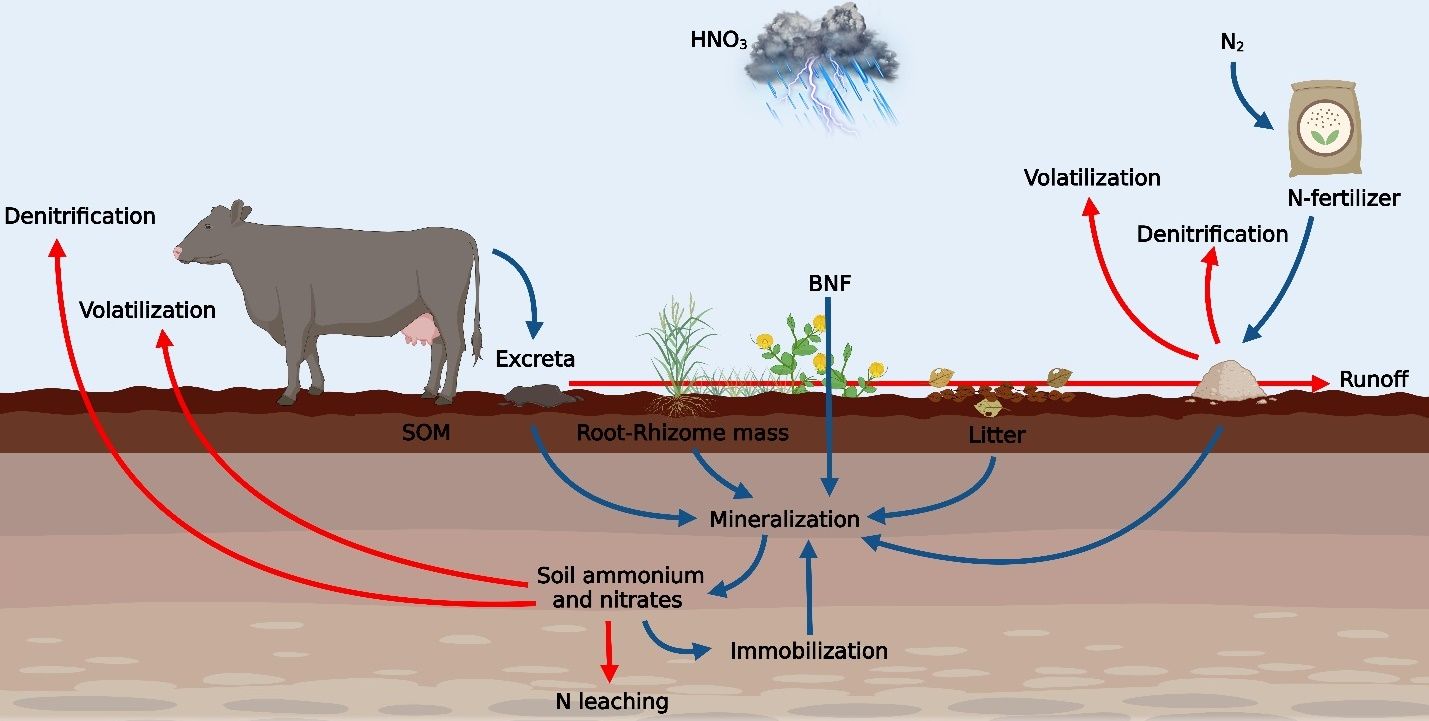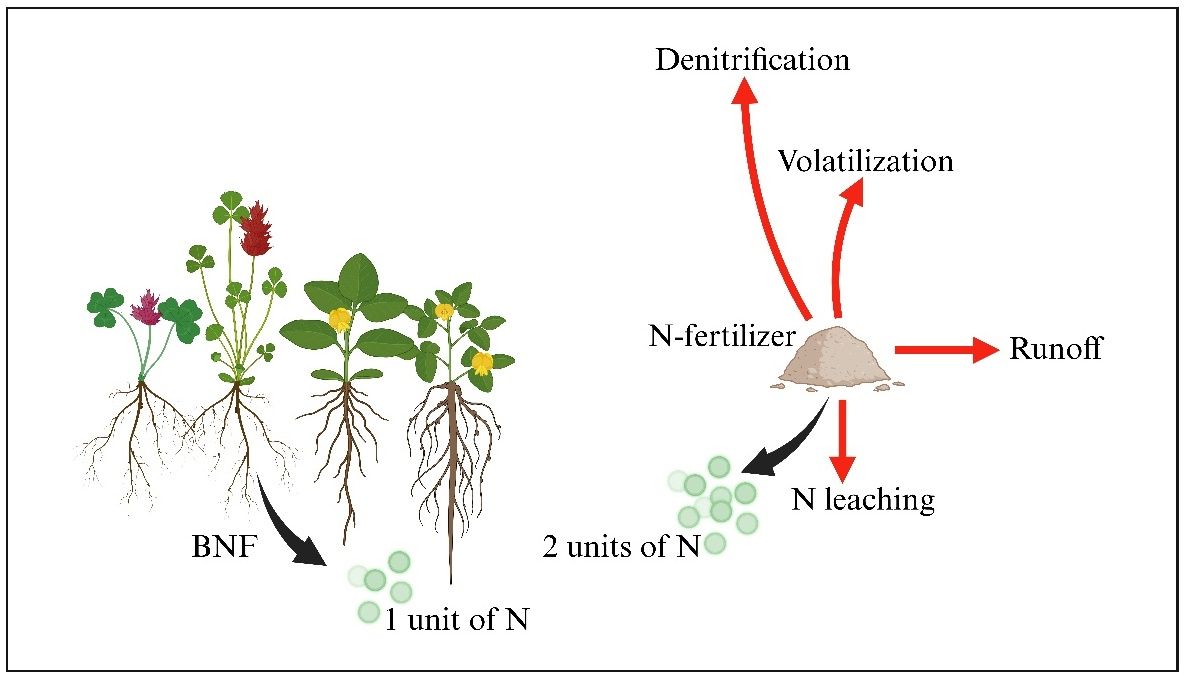Purpose and Target Audience
Nitrogen (N) is a key element in promoting plant and livestock growth and production. The two major ways to add N in pastures are fertilizer and integrating N-fixing forage legumes. The purpose of this publication is to compare these two options for cattle producers, farmers, Extension agents, and policymakers.
Nitrogen Cycle
Nitrogen plays an essential role in pastures because it is a critical nutrient for plant growth and nutritive value (Dubeux et al. 2007). However, N is a mobile nutrient and can be easily lost from the system (Galloway et al. 2004). In pastures, N moves through different pathways (Boddey et al. 2020) (Figure 1). First, atmospheric N is added to the system either via external N fertilizer inputs or biological N fixation from legume plants. It can then be taken up by plants, becoming part of the plant tissue, which may or may not be consumed by livestock. The portion that animals do not consume senesces and becomes aboveground dead plant material (litter), which, after decomposing, returns N to the soil. The plants that animals consume are digested and N is either converted to protein to be used for biological processes in the animal or excreted through urine and manure. Cattle return 70% to 90% of the total N consumed to the ecosystem through excreta (Vendramini et al. 2014). The pattern of N return to the pasture through urine and manure is much less uniform than litter depositions; however, N from manure and urine is more rapidly available for plant uptake since it is at least partially broken down during animal digestion. Losses to the atmosphere accompany all these N fluxes and movements through ammonia (NH3) volatilization and nitrous oxide (N2O) emissions, as well as losses through N leaching (Williams and Haynes 1990). Together, these losses reduce the N-use efficiency.
Unlike N provided from external sources such as fertilizer, N added via N fixation by forage legumes is used more efficiently since it is already in the plant. In contrast, N fertilizers are externally applied and susceptible to losses and need to go through biological transformations before plants can take them up from the soil.

Credit: Created in BioRender. Trumpp, K. (2025) https://BioRender.com/z8slxfu
Fertilizers
Nitrogen fertilizers are valued due to rapid availability for plant uptake after application (Singh et al. 2023). Apart from economic reasons, other limitations to their use include losses of N to the atmosphere through NH3 and N2O. Additionally, water movement can cause N losses by runoff and leaching, resulting in the contamination of water bodies and a reduction in the efficiency of N fertilizer use.
If urea is the N fertilizer source, there may be significant N losses when applied to the soil surface, especially as NH3. This loss can represent 50% to 60% of the N fertilizer applied, depending on weather conditions (Bouwman et al. 2002). For example, if a producer applies 100 lb of N as urea fertilizer, 50–60 lb may be lost due to volatilization, leaching, and other processes, leaving 40–50 lb in the system.
Legumes
An alternative N source is the inclusion of N-fixing plants (i.e., forage legumes) in pastures (Vendramini et al. 2014). The N fixation process depends on a symbiosis between plant roots and soil microorganisms. In grass-legume mixed pastures, the amount of N fixed by forage legumes depends on the proportion of legumes in the pasture, as well as the N concentration in the soil. Recommendations on desired legume proportions in mixtures range from 20% to 45%.
An ongoing study (2014 to present) at UF/IFAS NFREC (Marianna, FL) has shown the potential biological N fixation (BNF) of the rhizoma peanut (Arachis glabrata Benth; RP) into bahiagrass pastures (Paspalum notatum Flüggé). This study has different grass monoculture and grass-legume mixtures with different N fertilization rates during cool and warm seasons. The grass monoculture (bahiagrass only) receives N fertilizer at a rate of 100 lb N/acre during the warm season. It is overseeded with cool-season grasses (RAM oat and Prine ryegrass) during the cool season (fall) and receives another application of N fertilizer at 100 lb N/acre. In total, this system receives 200 lb N/acre/year. The grass-legume system is a bahiagrass-rhizoma peanut mixture during the warm season with no N fertilization. In fall, it is overseeded with cool-season grasses and a blend of clovers (RAM oat-Prine ryegrass with a crimson-red-ball clover mix) and receives a fertilizer application of 30 lb N/acre/year. The grass-legume pasture fixed 92 lb N/acre/year (Trumpp 2024), reducing the production costs and N losses and making this system more sustainable and efficient (Table 1). Animal gains were at least as great for the mixture as the N-fertilized grass (Table 2), yet the external N inputs from fertilizer provided to the grass-legume system were 85% less than the N-fertilized grass (Jaramillo et al. 2021). This implies that the N provided from N fixation by the legume was used around twice as efficiently as the N from N fertilizer (Table 1), meaning that 1 unit of N from the legume is equivalent to about 2 units of fertilizer-N input (Figure 2). Including forage legumes into pastures allows a replacement of N fertilizer by legume N via BNF, and also provides a more sustainable way of providing N to the plant. This results in lower farm production costs due to decreased expenses for N fertilizer. This N efficiency is also observed in gains of cattle in the grass-legume treatment; they gained at least as much as those on the grass monoculture but with only half the amount of N used per acre (considering N from fertilizer and legumes; Table 2).

Credit: Created in BioRender. Trumpp, K. (2025) https://BioRender.com/m5shsar
Other studies about forage legumes in Florida show the potential BNF of different species. To illustrate this, a mix of clovers during the cool season can fix around 30 lb N/acre (Pereira Neto et al. 2024). During the warm season, aeschynomene (Aeschynomene americana L.) fixes about 0.9–3 lb/N/acre, sunn hemp (Crotalaria juncea L.) fixes 23–72 lb/N/acre (Garzon et al. 2021), and perennial peanut (Arachis hypogaea L.) fixes 27–178 lb/N/acre (Jaramillo et al. 2018).
Implementing forage legumes is usually limited. Some restrictions include the long periods of establishment, more complex herbage management, and avoidance of extended fallow periods. The establishment period for forage legumes can go from one to three seasons depending on the species. In addition, animals prefer to graze legumes, so grazing management is necessary to maintain a good stand and persistence of the pasture. Other limitations are related to the complexity of weed management and difficulties in obtaining the initial planting material.
N Balance
The inclusion of forage legumes in pastures provides a more sustainable N source which enhances pasture N cycling (Homem et al. 2021). This is explained by a more efficient use of N and an overall reduction of N losses. The inclusion of forage legumes in grass-based pastures will improve the long-term N dynamic, making these pastures more sustainable compared with the N-fertilized grass-only pastures (Table 3).
Conclusion
Pastures are dependent on N for plant and animal growth. Utilizing forage legumes improves N cycling and sustainability and helps to reduce costs due to the use of less N fertilizer. In addition, the N provided by forage legumes is used more efficiently because it decreases losses within the grazing system and reduces dependence on external N inputs. However, it is important to analyze and consider the cost of the forage legume establishment and the withholding period until the mixed pasture can support grazing animals. Producers interested in rhizoma peanut planting and establishment can refer to Ask IFAS publication SS-AGR-349, “Rhizoma Perennial Peanut” (https://edis.ifas.ufl.edu/ag358).
Overall, including forage legumes enhances N cycling, decreases production costs, and reduces environmental issues related to N fertilization. Other ecosystem services that forage legumes provide are the improvement of forage and livestock responses, habitat for wildlife and pollinators, greenhouse gas mitigation, and carbon sequestration.
References
Boddey, R. M., D. R. Casagrande, B. G. C. Homem, and B. J. R. Alves. 2020. “Forage Legumes in Grass Pastures in Tropical Brazil and Likely Impacts on Greenhouse Gas Emissions: A Review.” Grass and Forage Science 75 (4): 357–371. Blackwell Publishing Ltd. https://doi.org/10.1111/gfs.12498
Bouwman, A. F., L. J. M. Boumans, and N. H. Batjes. 2002. “Estimation of Global NH3 Volatilization Loss from Synthetic Fertilizers and Animal Manure Applied to Arable Lands and Grasslands.” Global Biogeochemical Cycles 16 (2). https://doi.org/10.1029/2000gb001389
Dubeux, J. C. B., L. E. Sollenberger, B. W. Mathews, J. M. Scholberg, and H. Q. Santos. 2007. “Nutrient Cycling in Warm-Climate Grasslands.” Crop Science 47 (3): 915–928. https://doi.org/10.2135/cropsci2006.09.0581
Galloway, J. N., F. J. Dentener, D. G. Capone, E. W. Boyer, R. W. Howarth, S. P. Seitzinger, G. P. Asner, C. C. Cleveland, P. A. Green, E. A. Holland, D. M. Karl, A. F. Michaels, J. H. Porter, A. R. Townsend, C. J. Vörösmarty, V. Vöro, and V. Vörösmarty. 2004. Nitrogen Cycles: Past, Present, and Future.
Garzon, J., J. M. B. Vendramini, M. L. Silveira, P. Moriel, H. M. S. da Silva, J. C. B. Dubeux, M. Kaneko, C. C. Carnelos, and P. A. Mamede. 2021. “Harvest Management and Genotype Effects on Sunn Hemp Forage Characteristics.” Agronomy Journal 113 (1): 298–307. https://doi.org/10.1002/agj2.20465
Homem, B. G. C., I. B. G. de Lima, P. P. Spasiani, B. C. Guimarães, G. D. Guimarães, T. F. Bernardes, C. de P. Rezende, R. M. Boddey, and D. R. Casagrande. 2021. “N-fertiliser application or legume integration enhances N cycling in tropical pastures.” Nutrient Cycling in Agroecosystems 121 (2–3): 167–190. https://doi.org/10.1007/s10705-021-10169-y
Jaramillo, D. M., J. C. B. Dubeux, C. Mackowiak, L. E. Sollenberger, N. DiLorenzo, D. L. Rowland, A. R. S. Blount, E. R. S. Santos, L. Garcia, and M. Ruiz-Moreno. 2018. “Annual and Perennial Peanut Mixed with ‘Pensacola’ Bahiagrass in North Florida.” Crop Science 58 (2): 982–992. https://doi.org/10.2135/cropsci2017.09.0542
Jaramillo, D. M., J. C. B. Dubeux, L. E. Sollenberger, J. M. B. Vendramini, C. Mackowiak, N. DiLorenzo, L. Garcia, L. M. Luana, E. R. S. Santos, B. G. C. Homem, F. van Cleef, and M. Ruiz-Moreno. 2021. “Water Footprint, Herbage, and Livestock Responses for Nitrogen-Fertilized Grass and Grass–Legume Grazing Systems.” Crop Science 61 (5): 3844–3858. https://doi.org/10.1002/csc2.20568
Pereira Neto, J. D., J. C. B. Dubeux, M. V. F. dos Santos, E. R. Santos, I. L. Bretas, D. Jaramillo, M. Ruiz-Moreno, P. da Cruz, L. Queiroz, K. Oduor, and M. A. Bernardini. 2024. Herbage Responses and Animal Performance of Nitrogen-Fertilized Grass and Grass-Legume Grazing Systems.
Singh, H., L. Sharma, L. Johnson, E. Carter, and P. Devkota. 2023. “Mitigating Nitrogen Losses in Row Crop Production Systems.” EDIS 2023 (1). https://doi.org/10.32473/edis-ag467-2023
Vendramini, J. M. B., J. C. B. Dubeux, and M. L. Silveira. 2014. “Ciclagem de nutrientes em pastagens tropicais.” Revista Brasileirade Ciências Agrárias 9 (2): 308–315. https://doi.org/10.5039/agraria.v9i2a3730
Williams, P. H., and R. J. Haynes. 1990. Influence of Improved Pastures and Grazing Animals on Nutrient Cycling within New Zealand Soils. 49–57.
Table 1. External N inputs for Grass+N fertilizer and Grass+Legume. BNF = Biological N fixation.
Table 2. Animal performance for Grass+N fertilizer and Grass+Legume pastures.
Table 3. Nitrogen inputs, losses, and balance for two pasture systems.